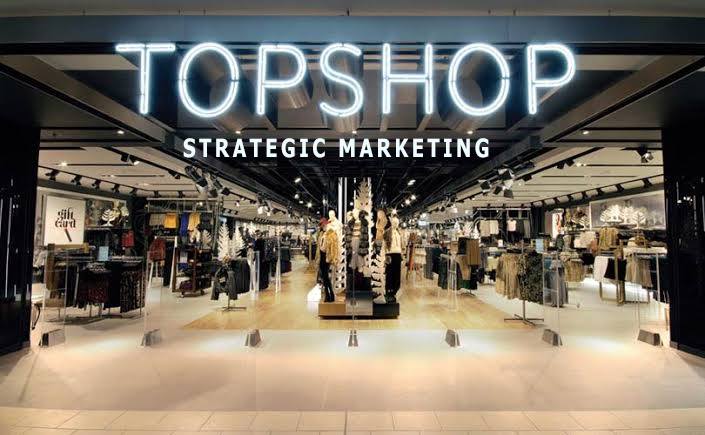Strategic marketing is a mode implemented by an organization to offer better services and create value for its customers. Strategic marketing aims to focus on the differentiated aspects of product development and acquire competition over the market.
The competing environment for a company decides, where, how, and when to compete with its competitors based on strategy. Strategic marketing of Topshop is the topic for the day.
Strategic marketing planning is defined under brand planning and plans for future development. The managerial approach undertakes the quality and specific marketing framework to understand the critical market environment for product development.
Through a market mix strategy, a company can undertake a variety of components to strengthen its brand strategy and sell its product. This strategic marketing paper will address the key marketing objectives of the Topshop brand, its internal and external environment, and its marketing objectives.
The Topshop Brand
Topshop is a UK-based retailer of fashion clothing, designer’s shoes, makeup items, cosmetics, and other accessories. It initiated its business operations in 1964, with headquarters based in London.
Today, it has transformed into a global conglomerate, with around 620 outlets in different parts of the world, while some 300 are in the UK alone.
Its global outreach is continuously on the move. Besides, it also managed monumental online business transactions in various related markets and industries. Topshop is a part of the Arcadia Group.
Analysis of Internal Environment
The internal environment of Topshop helps to determine brand value and key competitive strengths. The brand is a global marketing manager and works on a focused approach to changing lifestyles. This fashion retail market is developing based on marketing strategy and digital involvement.
The internal environment of Topshop elaborates on the brand value, strategic objectives, and competitive analysis of the company.
Brand Value
Topshop is a personality-building brand that targets the status of conscious customers. The brand’s strategy is based on its daily interaction with the market. The marketing campaign and brand value are interlinked because it uses messages for customers’ attraction, proposals, and website images to capture their attention.
The brand focuses on creating a unique value in customers’ minds with a fresh look.
Genuine endorsements from the public are a continuous framework for workers and management to set high goals. The constant innovation strategies are aligned with the marketing dimensions through advertising.
Cara Delevingne, through her calm and quirky image, has spread a unique character. A brand target market is a fashion-forward approach with a broad emphasis on innovation through its flagship store.
Brand value is generated with a complete focus on marketing and advertising campaigns with substantial involvement in digital media.
Strategic Objectives of Topshop Brand
In this era of the digital revolution, no global giant can afford to be left behind, and Topshop is no exception. Topshop is committed to strategically using digital media to coordinate with its worldwide customer base.
They are utilizing social media, including Facebook and other channels, to cater to their customer needs cost-effectively.
The Arcadia Group has recently attracted three senior resources to fill its digital team as the group is desperate to achieve a high digital presence.
It is worth mentioning that Topshop’s strategy of using social media as their marketing tool is paying dividends and has proved very successful as they regularly inform their customers about new arrivals and trends, which are fascinating for the thirsty fashion generation.
Product Differentiation
Besides invading social media and digital platforms, Topshop has devised an exclusive strategy focusing on product differentiation to gain an ultimate market share in the fashion industry.
Topshop now focuses on the new dimensions of exclusivity and inimitability by concentrating on novel and creative design. Resultantly, Topshop is currently developing style products that are satisfactorily distinguished.
Its diversity has permitted it to gain a remarkable marketplace in the fashion industry despite the fierce competition from companies like ZARA and H&M. Besides, the pledge to originality and ingenuity has enabled Topshop to keep pace with changes in the fashion industry.
As a novel marketing strategy, Topshop announced in Sep 2019 its “Landing to Retail strategy.”
It allows the customers to shop and edit Topshop’s products from the runway. This is a significant shift from the luxury market to accommodate the client’s pressing needs.
Competitive Analysis of the Company
The current marketing situation of the Topshop brand is modest. Once termed the ultimate king of young fashion dreams with elite fan clubs and a permanent mark on the London Fashion Week programs, it is losing its charm due to intense competition in the fashion industry.
In August 2016, the Arcadia Group presented its financial results, which were not as promising as they used to be, as it reported a 16% reduction in net profits.
It is relevant to mention that cut-throat competition from other local and international brands and ever-changing consumer tastes are making Topshop’s global position difficult.
Product strategy:
Topshop has introduced various product variations as part of its product strategy. The firm now deals in large product lines, namely a wide range of apparel, fittings, and fixtures, in harmony with the customers’ changing needs and demands.
Topshop has high regard for the quality of its products with new styles and comfort. Topshop’s primary range of products is dresses, jackets, jeans, knitwear, and shoes.
One of the challenges facing the fashion industry is the fast rate of change arising from its vibrant nature. The Topshop brand is committed to attaining a high degree of imagination and improvement to meet the challenge of change.
It marvelously attributed to the firm’s proficiency in bringing new products to its shops. To preserve the charge of its products, it ensures that it introduces only a fraction of a specific product line. It helps them position their products as exclusive.
Pricing strategy:
Most of the customers around the world are very price-conscious and want the best return for their money. Business firms follow a pricing strategy that effectively conveys the value of their products or services.
Topshop follows a unique quality pricing strategy, enabling it to collaborate with the firm’s high-quality apparel and accessories.
Customers have now learned to link Topshop’s products with value, where price took a back seat.
Promotion strategy:
Adopting an effective promotion strategy is so indispensable for today’s business environment that no firm can afford to take a lenient view. One of Topshop’s marketing tools is informing customers of its products, promotional schemes, and fashion trends.
Topshop brand has initiated the following Integrated Marketing Communication (IMC) strategy. It enables Topshop’s use of several communication tools like publicizing, sales promotion, and public awareness.
Place strategy:
More than just designing or evolving products and services, firms must ensure customers have easy access to them. If a firm designed or developed an excellent product that is not reachable by the customers, that is a total loss of time and resources.
Topshop has already established a decent number of outlets to enhance product availability.
The outlets are successfully located to expand customer accessibility. Topshop brand has also used an online shopping option where customers can now shop for Topshop’s products online.
It is effective that Topshop reaches its customers online and offers them many choices of its products.
Analysis of External Environment
The external environment of Topshop shows the micro and macro environment. Under which PESTEL analysis exists. The external environment identifies a company’s position through its strengths, weaknesses, opportunities, and threats.
It will also consider the Ansoff matrix, which sheds light on a firm’s marketing strategy by understanding key risks.
Micro Environment
The microenvironment is all about forces that affect the business market through competitors, suppliers, and customers. The customer base of the Topshop brand is youthful, from 15 to 29 years of age.
UAE has high consumer spending habits and can offer an excellent investment opportunity. UK and US are also targeted areas of the company to consider the increased spending power of teens.
Topshop targets teenagers by attracting them to unique products with discounts and promotions.
Online trends and digital presence are crucial marketing approaches that have engaged millions of customers across the globe. The fashion sense of the company is innovating due to cultural variation.
It plans to stay ahead of its competitors by producing innovative designs and strategies.
The secure positioning of the brand in China and the UK targets youth by fulfilling their demands.
The brand has collaborated with prominent fashion designers in the industry to develop an innovative, fashionable piece of clothing.
The critical designers involved with the brand are Christopher Kane, Alexander McQueen, Kate Moss, and others.
The suppliers of the company are different, such as Arcadia. Its relationship is strong with Topshop, and 54% of Arcadia’s suppliers are engaged with the brand. The top suppliers of Topshop focus on 43% of product delivery.
Turkey, China, India, and Russia suppliers are involved with the brand.
The brand’s distribution channels are physical and virtual. These channels are used explicitly for communication purposes. Some critical aspects of the distribution channels are the Topshop App, Independent Stores, and online websites.
Through the Topshop App, potential customers acquire access to save and shop, and people quickly access barcodes to know stock availability. The independent stores are present in the UAE and many other places worldwide. The digital framework is represented by online websites that sell female and male clothing.
Macro Environment
To fully fathom Topshop’s strategic marketing decisions, it is necessary to discuss its internal and external factors in the light of the marketing mix and SWOT analysis.
The success of a business in selling its products depends on the efficiency of its marketing strategies. Marketing strategies consider several factors like product, promotion, price, and place, commonly known as the four Ps of marketing.
Topshop’s macro-environment explains PESTLE analysis, SWOT, and Ansoff matrix.
PESTLE Analysis
The political factors constitute a country’s political environment, economic stability, and trade agreements. The UK government is working under highly stable political conditions. Investors are performing satisfactorily in the UK.
The trading blocks, G20, European Union, and economic cooperation are bodies that actively involve the UK.
The Topshop brand can export its products to other states, and the economic integration with other countries helps access raw materials and cost-effective trade.
The economic environment is all about stable economic conditions, economic recession, global rates, and consumption of luxuries. Globalization is developing the fashion sense in the public.
In the UK, the economic downturn of 2008 declined the purchasing power of buyers, but the depression made people focus on necessities rather than luxuries.
Due to the continued consumption of products, companies’ production increased, and the focus was shifted to fashionable products. Topshop has a favorable scope in the UK to prosper and engage young people to increase production.
The social environment concerns social trends and how consumers engage with famous brands to cope with society. For Topshop Company, the social trends in the UK and China are favorable due to fashion sense.
People focus on unique, quality, and fashion products to align with the latest social trends.
Digital Factors
Technological factors for Topshop are all about the digital environment and online presence with networking technology. The use of Facebook, Twitter, and YouTube is helpful for customers’ interaction. This process is applicable to bring a volume of market-related information under changing perspectives of the environment.
The statutory factors in a state that can influence a company are tax rates, government matters, and investment rules. The government’s involvement in tax returns and valuable policies for investment are significant for Topshop Company. There is a chance for the company to acquire a high level of profitability.
Environmental factors that can spread the brand image and recognition are corporate social responsibility and a focus on environmentally friendly raw materials. Topshop brand can focus on green and recyclable raw materials for its production.
Porter’s Five Forces of Competitive Position Analysis:
To understand Topshop’s Competitive Position Analysis, it is essential to discuss it in light of Porter’s five forces of supplier power, buyer power, competitive rivalry, the threat of substitution, and the threat of entry.
Supplier Power: It is almost non-existent as Topshop mainly produces its products and accessories and is not dependent on any suppliers for its end products. For the procurement of raw materials, Topshop uses its global brand and image power and strikes lucrative deals with different suppliers from all over the world.
Buyer Power: The Fashion industry is dynamic, with many players operating with an ever-increasing product range. Today, a customer has a broader range of options from which to choose. It forces Topshop to fetch customer trust to maintain its growth. Besides, the continuous availability of its premium quality products is a must.
Competitive rivalry: The fashion industry is very lucrative and profitable worldwide, attracting a growing number of players. Only in the UK do a substantial number of fresh players enter the fashion industry every year, which poses a certain degree of rivalry for Topshop.
The threat of substitution: Due to the availability of many products, the customer has the liberty of substitution. During an economic slump, customers can shop for apparel and other accessories from next-door superstores and other inexpensive retail outlets.
The threat of Entry: Many large retail chains, such as supermarkets and hypermarkets, exist in the UK. They are moving to diversify their merchandise by containing various attires and accessories. This, of course, presents a viable challenge to the Topshop brand. Online shopping options also offer excellent opportunities for new entrants to expand their business. To thrive in this environment, Topshop must go digital.
SWOT Analysis
Topshop’s strength primarily lies in its formidable brand image, which is recognized worldwide. Fully aware that the fashion industry is quite volatile and trend-sensitive, it invested heavily in maintaining its competitive edge.
Topshop’s products are used by many international celebrities, which is a brand endorsement. Satisfactory customer experience is the strength of Topshop, as customers value product quality and store ambiance.
On the weakness front, the high cost of doing business, in the shape of human resources and overhead-related expenses, poses a challenge to Topshop. Secondly, another monumental challenge is management issues of large stores along with innumerable product lines.
Topshop brand can explore opportunities in new market niches like youth, senior citizens, and middle-aged generations. It can increase its brand equity by partnering with global celebrities. Its revenue size can be multifold by penetrating new markets and expanding the brand.
Like all global corporations, the Topshop brand faces significant threats from competition from local and international brands like Emporio Armani, Christian Dior, Mango, and Gucci. Economic recession is also a considerable threat facing all corporations. It affects its revenue stream with declining sales volumes.
Ansoff Matrix
The Ansoff matrix is about the evaluation and understanding of business risks. Market penetration is prevalent through distribution channels, loyalty schemes, and price reductions. Topshop brand has a competitive market, and the established market players focus on innovative practices.
Market development is selling a product to people with complete knowledge about the market. A riskier strategy by the Topshop brand is product development. It is about selling unique and innovative products to existing customers. This needs customer understanding and their preferences.
Diversification explains the reaction of customers to a product, the transformation in market dynamics, the differentiation of the product, and the customers’ needs. This high-risk category is for investors and helps to develop a powerful partnership.
Marketing Strategy
Marketing strategy is how a company focuses on its strengths to acquire a new customer base and develop its product channels. Topshop brand is focusing on a unique product strategy by product diversification.
The firm deals with various accessories and clothing to satisfy customers’ needs. The company focuses on high-quality products, design, and style to align with the latest trends in fashion.
The apparel industry is facing challenges in consumer dynamics. The changing nature of consumer preferences is addressed by upgrading the products and focusing on the firm’s ability to build new products.
The pricing strategy is based on the communication and involvement of marketing approaches and promotions. Sales and promotions, marketing communication, and public relations are critical aspects of promotional strategy.
Marketing Programs
Topshop’s critical marketing programs include marketing mix strategies and promotions. The brand has high recognition in UK fashion outlets. Its runway debut in 2005, its Summer/winter collection, and the high-end label have made its products versatile.
The luxury brocade, upmarket material, and elegant aesthetic create a prominent fashion sense.
Topshop brand collaborates uniquely with Wedgwood, Jasperware, and Wild Strawberry heritage brands. The product development strategies with an alliance of British brands strongly focus on design and style.
The Topshop brand specializes in ‘made-in-house’ products. It utilizes high-quality premium fabric because its unique products offer high-price compared to its competitors.
The company’s price range is broad; it offers different season collections and luxury brands. The up-to-date fashion and variable pricing trends are based on demographic patterns.
The brand functions align to marketing strategies and promotion policies. With its different marketing programs, it engages with social media platforms, such as digital recognition.
The social media platforms like Twitter, Facebook, Instagram, and online presence like websites are engaging for customers.
Resource Commitments
In China, the Topshop brand is entering the market by acquiring a license with fewer resource commitments. This attractive aspect for the firm is based on the utility of little capital, thereby entering rapidly. Through this process, market knowledge, customer interaction, and distribution of products offer convenience.
Another marketing program by Topshop is the entry mode strategy in the UK and selling products in China.
The famous global brand focuses on adequate experience and strengths to avoid waste while enabling marketing conditions.
Resultantly, the Topshop brand can claim a high degree of customer approval. It has used social media and digital portals to the entire benefit of marketing its products.
Topshop’s Strategic marketing successfully maintains its international brand image and consistently capitalizes on it.







